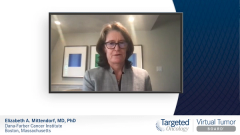
IMpassion130 and KEYNOTE-355 Trials in Patients With Metastatic TNBC: Part 2
Hope Rugo, MD, continues to discuss key clinical trials affecting metastatic triple-negative breast cancer, including IMpassion131.
Episodes in this series

Hope Rugo, MD: Both atezolizumab and pembrolizumab have accelerated approval from the FDA based on the data from the 2 trials we just discussed. When we try to decide which chemotherapy and checkpoint inhibitor we should use, we base the clinical trials on our decision-making process. First, all women with metastatic triple-negative breast cancer should have testing for PD-L1 as soon as possible after their diagnosis. This testing can be done on any tumor sample that’s available. If it’s not feasible to obtain a metastatic tumor biopsy, send the archival sample from their early stage diagnosis.
If you can get a biopsy, it’s important, because you want to retest those markers. You always want to be sure you’ve confirmed that the tumor is triple-negative and something wasn’t missed on the testing of the early-stage disease. At that point, you have tumor tissue that can be sent for PD-L1 testing. If 1 test for PD-L1 is negative, there isn’t an overall guideline approach. But because there isn’t a complete overlap and this is such an important decision for our patients, it’s reasonable to send the other test to be sure the patient’s tumor is really negative for PD-L1 by all tests available.
There also has been some discussion about which organ you should get the tumor from. That seems a little beyond what we can do in clinical practice. You’re not going to biopsy the lung rather than the liver because there’s a higher rate of PD-L1 positivity in the lung. It’s true that the lung may be more likely to be positive than the liver, and that might motivate you if you find a negative test to go back and check the archival breast tumor sample to see if some of the cells might be PD-L1 positive, but you’re just not finding them in the liver. We don’t know the implications of discordant testing to response to checkpoint inhibitors. If patients relapsed after 12 months, I would use the IMpassion130 data with nab-paclitaxel and atezolizumab.
Data from IMpassion131 that was presented at ESMO [European Society for Medical Oncology] Virtual Congress in 2020. This trial looked at a similar population to IMpassion130, with a slightly different randomization, with an intent-to-treat population and then a plan to look at the PD-L1–positive population. Patients received paclitaxel rather than nab-paclitaxel, and for that reason, they received steroids. There was absolutely no difference in the PD-L1–positive population for progression-free survival [PFS] or overall survival. In fact, the cohort of patients who had PD-L1–positive disease and received atezolizumab and paclitaxel had a slightly numerically worse survival than the control population, although this was in no way statistically significant.
What’s intriguing about this is that the median overall survival for the control population was 28 months. We haven’t seen that in any other study. It’s longer than we’ve seen. What you take from that study is that there’s some variable that we don’t understand that by chance picked a patient population that had very chemotherapy-sensitive disease in IMpassion131. Hopefully, additional correlative studies might help to elucidate what population that represented. It certainly could be steroids with atezolizumab, although steroids were used in KEYNOTE-355 with paclitaxel and gemcitabine and carboplatin, and a PFS benefit was seen. We are waiting for overall survival data from KEYNOTE-355, but crossover to checkpoint inhibitors in some countries because of the accelerated approval of atezolizumab may complicate this analysis.
Transcript edited for clarity.












































